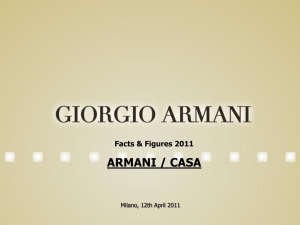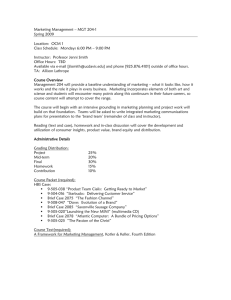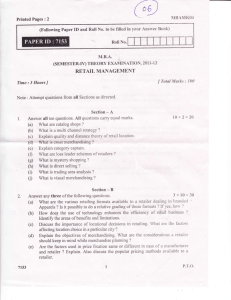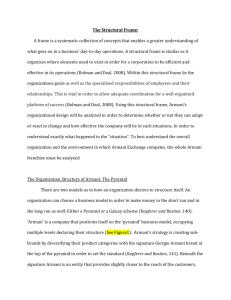- University of Huddersfield Repository
advertisement
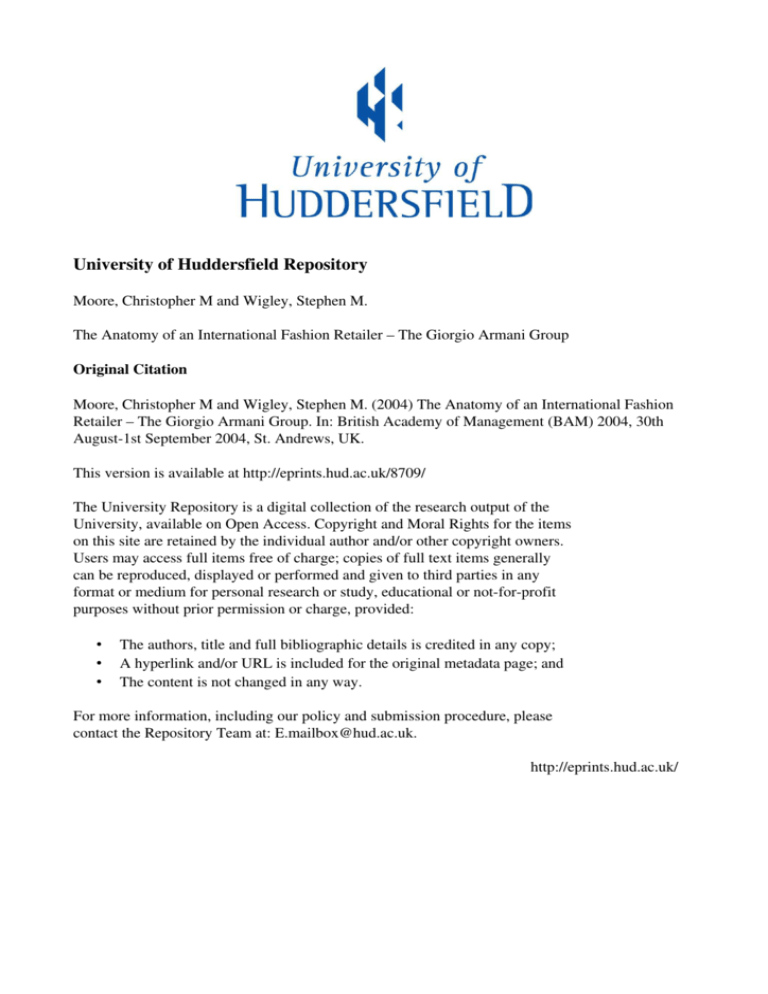
University of Huddersfield Repository Moore, Christopher M and Wigley, Stephen M. The Anatomy of an International Fashion Retailer – The Giorgio Armani Group Original Citation Moore, Christopher M and Wigley, Stephen M. (2004) The Anatomy of an International Fashion Retailer – The Giorgio Armani Group. In: British Academy of Management (BAM) 2004, 30th August-1st September 2004, St. Andrews, UK. This version is available at http://eprints.hud.ac.uk/8709/ The University Repository is a digital collection of the research output of the University, available on Open Access. Copyright and Moral Rights for the items on this site are retained by the individual author and/or other copyright owners. Users may access full items free of charge; copies of full text items generally can be reproduced, displayed or performed and given to third parties in any format or medium for personal research or study, educational or not-for-profit purposes without prior permission or charge, provided: • • • The authors, title and full bibliographic details is credited in any copy; A hyperlink and/or URL is included for the original metadata page; and The content is not changed in any way. For more information, including our policy and submission procedure, please contact the Repository Team at: E.mailbox@hud.ac.uk. http://eprints.hud.ac.uk/ The Anatomy of an International Fashion Retailer – The Giorgio Armani Group Christopher Moore & Stephen Wigley* Glasgow Caledonian University Division of Marketing Caledonian Business School Cowcaddens Road Glasgow G4 0BA Telephone: 0141 331 8264 Email: stephen.wigley@gcal.ac.uk Fax: 0141 331 8210 Track: Working Paper The Anatomy of an International Fashion Retailer – The Giorgio Armani Group Introduction Of all the international retailers, luxury fashion retailers are typically the most prolific as measured by the number and diversity of foreign markets in which they operate. Furthermore, for most, the contribution of foreign sales to total sales is equal to, if not greater than, that achieved by the most active international retailers (Moore & Fernie 2004). Yet, while the significance of the luxury fashion retailers’ foreign activities is now acknowledged in the international retailing literature, there have been calls for more in-depth, company specific appraisals of the strategies adopted by such firms (Doherty 2000; Moore, Birtwistle & Burt 2004). Doherty (2000) has argued in particular that further case study research in the area of fashion retailer internationalisation would provide much needed insights into the apparatus that supports their international success. The aim of this paper is to examine the strategic apparatus – the business model – that defines and supports the international market success of the Giorgio Armani Group. This company is worthy of particular attention on the basis of its extraordinary geographic spread; its 25 year history as an international retailer; and the contribution of foreign sales to total sales in excess of 84% in 2002 (Giorgio Armani Group 2003). Furthermore, and perhaps as importantly, the Giorgio Armani name has been identified as one of the worlds most recognised and respected international fashion brands. A starting point in understanding the anatomy of the Armani internationalisation strategy is provided by Giorgio Armani himself. Reflecting upon the €653 million internal investment made by the company in the past five years (funded entirely by internal company reserves), he explains that this expenditure has been committed to the apparatus of the Giorgio Armani Group’s international activities. Specifically, it has “been committed to key strategic priorities: the expansion of our dedicated manufacturing capacity; the growth and diversification of our product (and brand) portfolio; and the continuing enhancement of our retail store network” (Giorgio Armani Group 2003). The literature on fashion retailing has hinted at the importance of each of these dimensions – namely manufacturing capacity, brand and product portfolio and the retail store network (Moore & Fernie 2004). The following section will review recent studies of these dimensions in the literature and will conclude by suggesting that while the importance of each is recognised, they are not understood in terms of their collective contribution to international retailing success. Literature One of the most striking deficiencies in the international retail literature is the lack of research into the specialised subject of fashion retail internationalisation, notwithstanding the consensus that fashion companies are prevalent and successful international retailers (Hollander 1970; Fernie, Moore, Laurie & Hallsworth 1997; Doherty 2000; Moore 2001). Given its specialised demands and characteristics, authors argue that conclusions derived from the general internationalisation literature may be inapplicable to fashion retailing (Fernie et al 1997; Doherty 2000; Fernie, Moore & Fernie 2003;). Such research as has been carried out into the international fashion retail sector has indicated some of its distinguishing circumstances. Most important are the internal corporate characteristics of international fashion retail companies (Dawson 1993; Moore, Fernie & Burt 2000), the importance of brand presentation and product differentiation (Laulajainen 1992; Moore et al 2000; Moore 2001) and the variety of foreign market entry methods and control structures (Treadgold 1991; Doherty 2000; Quinn & Doherty 2000). Defining the success of an international fashion retailer is the ability of the retailer to manage these factors, establishing effective relationships within manufacturing, distribution, retail and marketing networks to present an appealing and coherent brand image across geographically and culturally diverse markets (Doherty 2000; Moore, Birtwistle & Burt 2004). A number of authors have cited brand appeal as a significant determinant of international retailer success (Hollander 1970; Alexander 1990 & 1995; Williams 1992; Dawson 1994). Given its culture-bound nature, this is especially the case for fashion retailers (Laulajainen 1992; Fernie et al 1997; Moore 2001). Moore (2001) cited ‘the brand’ as a key determinant of fashion retailer success, differentiating the retailer from its competitors by generating a distinctive image, and satisfying the consumer’s functional and emotional values (Franzen & Bouwman 2001). Various case studies (e.g. Bunce 1989; Treadgold 1991; Belussi 1992; Johnson & Allen 1994; Arnold 2002) place the brand as central to the retailer’s business model (Martinez & de Chernatony 2004). Hence, in the contemporary commercial environment of multiple brand extensions, the coherency and appeal of the brand is important in creating appeal across many market segments and product ranges (Aaker & Keller 1990; Park et al 1991; Keller 1993; Dacin and Smith 1994; Bottomley & Holden 2001). Martinez and de Chernatony (2004) suggest that companies attempting to extend their brand into new product sectors or unfamiliar markets must have a strong parent brand enjoying high consumer familiarity, good extension fit and a positive consumer image. Contingent to building a coherent brand image in the fashion retail market is a disciplined distribution and retail strategy (Belussi 1992; Dawson 1994; Fernie et al 1997; Birtwistle & Freathy 1998; Moore 1998; Moore et al 2000). Dawson (1994) delineated the various market entry options available for a retailer seeking international expansion, with consequent implications for management control in those foreign markets. The chosen route is regarded as indicative of the retailer’s corporate characteristics and competencies and brand positioning (Treadgold & Davies 1988; Burt 1993; Sparks 1996), with luxury fashion companies typically adopting an approach facilitating the international presentation of a uniform and coherent brand image across different markets via centrally controlled advertising, retail operation and distribution partnerships (Hollander 1970; Laulajainen 1992; Crew & Lowe 1996; Fernie et al 1997; Moore 1998; Moore et al 2004). Regardless of the retail format or distribution strategy chosen, in considering international brand presentation and foreign retail operations as fundamental aspects of the business strategy, management control over foreign retail operations is critical (Doherty 2000; Quinn & Doherty 2000). Moore et al (2004) contend that managing the relationship between marketing channel and retail partners is essential to the success of fashion retailers. The Giorgio Armani Group Established in 1972, the Giorgio Armani Group distributes to over 120 countries and reported profits of €117.4m in 2002 (Giorgio Armani Group, 2003). As was indicated in the introduction, the central tenets of the Armani Business Model relate to their dedicated manufacturing capacity, the growth and diversification of the product (and brand) portfolio and judicious management of their international distribution network. Each of these dimensions will be examined below. Manufacturing Capacity In the past twenty years, international fashion retailers have abandoned their direct involvement in manufacturing and have delegated this responsibility to third parties in transactional relationships whereby the retailer specifies their conditions and requirements of a product. Licensing agreements allow suppliers to design and manufacture ranges that are then marketed under the fashion retailer’s own brand name (Moore et al 2004). These arrangements benefit the retailer by providing access to the technical expertise and resources of their manufacturers while at the same time reducing the risk that they may face with turbulent markets. It is rare for international fashion retailers to manufacture their own product ranges. The Giorgio Armani Group has adopted what may be described as “a countervailing manufacturing strategy”. In the past five years in particular, the Group has sought to complete the task of creating a vertically integrated business. From Giorgio Armani’s perspective, their continued success is dependant upon “an ongoing commitment to a strategy of vertical integration, where the Group increasingly takes direct control over all aspects of design, manufacturing, distribution and retail” (Giorgio Armani Group 2003). This is substantiated by their pursuit of a manufacturer-acquisition strategy – as evidenced by their acquisition of Deanna Spa (producer of high quality knitwear) and four footwear factories in late 2002. Figure 1 (below) delineates the scope of the Group’s manufacturing capability across all of their core product categories. Name Antinea Srl Deanna Spa Guardi Soa Intai Spa Activity 100%-owned men’s / women’s formal clothing manufacturer 100%-owned knitwear manufacturer 100%-owned men’s / women’s footwear manufacturer 100%-owned tie, underwear, beach, home furnishings and leather accessories manufacturer 100%-owned casual wear manufacturer di 51% - indirectly controlled men’s clothing manufacturer Simint Spa Confezioni Matelica Spa Borgo 21 Spa 60% - indirectly controlled manufacturer of couture line Figure 1 : Giorgio Armani Group – Manufacturing Capability The commitment to a vertical integration strategy is motivated by financial benefits and the desire to assure design protection and exclusivity. However, of particular importance to Giorgio Armani himself is his belief in the “integrity of the Armani brand around the world – the only way to truly protect this integrity is through the commitment to a strategy of vertical integration with direct control over all aspects of design, manufacturing, distribution and retail” (Annual Report 2003). In those areas where the Group does not possess the requisite expertise, it grants licences to third parties who are responsible for the manufacture and distribution, but not the design or marketing, of products in four specific categories: eyewear, perfumes, watches and jewellery. The Armani Brand Portfolio The desire for maximum control through vertical integration is imperative to the Group’s management of a brand portfolio comprised of six lifestyle brands – each of which, according to the Group, has its own personality, positioning, distribution and retail strategy. A review of each of the brands and their respective market positioning is presented in Figure 2 below. Brand Name Giorgio Armani Armani Collezioni Positioning The main line – couture equivalent Diffusion line of fine-tailoring, sportswear, outerwear and accessories for professionals Emporio Armani Young and modern diffusion line for younger customers AJ/Armani Jeans Youth line – with a focus on technology and ecology A/X Armani Exchange Entry level brand – fast fashion for denim and urban fashion Armani Casa Furniture and home accessories ranges Figure 2 : Armani Brands and Market Positioning Three dimensions define the Armani brand portfolio. The first relates to its market coverage of customer segments, while the second is their ability to retain mutualexclusivity between and among disparate groups of customers. The precision in terms of distinctive positioning and distribution of each of the six brands does not result in brand erosion. Finally, the portfolio is dynamic and entrepreneurial – in that it is responsive to market opportunities as evidenced by the establishment in 2000 of the Armani Casa home furnishings brand. Distribution Network In 2002 wholesale activity contributed 52.1% to the total Giorgio Armani Group turnover. Other than providing a significant revenue stream, wholesaling also provides significant foreign market coverage at a reduced risk. The Group retains rigid control over wholesale access through its subsidiary company – Giorgio Armani Distribuzione Srl – which vets all current and prospective stockists in terms of Groupstockist compatibility. The store network strategy is complex and reflects the positioning of the respective brands and the national markets. Of the 311 Armani stores worldwide, 115 are directly-owned by the Group. Direct ownership of all Armani stores in Italy, Japan and the USA is driven primarily by their significant contribution to Group profit. The control of Armani Collezioni stores in Paris and Frankfurt reflects an attempt to secure a premium brand positioning, while the non-availability of the AX/Armani Jeans in Europe ensures that Armani’s premium brand positioning is not confused by a mass-market priced product range in this most demanding market. Conclusions Manufacturing Vertical Integrated manufacturing of product ranges Licence agreements for specialist lines Brand Portfolio Six lifestyle brands – maximum segment coverage Distribution Wholesaling for cost-efficient market coverage Directly managed stores in key markets and for key brands In-directly managed stores with competent trading partners Figure 3 : Giorgio Armani Group Business Model Figure 3 represents three critical dimensions of the Armani business model of which three central observations can be made. Firstly, it is integrative which provides for maximum control and consistency in the management of the brand portfolio. Secondly, it is entrepreneurially dynamic – with the extension into complimentary product categories and the acquisition of strategic manufacturing capability. Finally, the evolution of the model has been measured and incremental. The Armani Group is 100% owned by Giorgio Armani himself. Free from shareholders’ demands, the ownership status of the Group has provided the freedom of a strategic planning approach that is not readily available to other international fashion brands. The presentation will provide further details of these dimensions and will consider, in particular, the inter-relationship between each and their respective contribution to the success of the Giorgio Armani Group. References Aaker, D.A. & Keller. K.L. (1990) “Consumer evaluations of brand extensions”, Journal of Marketing Vol.54 January pp.27-41. Akehurst, G. & Alexander, N. (1996), “Developing a Framework for the Study of the Internationalisation of Retailing”, in Akehurst, G. & Alexander, N., (eds.) The Internationalisation of Retailing, 1996, Frank Cass, London, UK. (pp. 204-209). Alexander, N. (1990), "Retailers and international markets: motives for expansion", International Marketing Review Vol.7 No.4 pp.75-85. Alexander, N. (1995) “Internationalisation – Interpreting the motives”, in McGoldrick, P. & Davies, G. (eds.) International Retailing – Trends and Strategies, 1995, Pitman, London UK. Arnold, S. (2002) “Lessons learned from the world’s best retailers”, International Journal of Retail and Distribution Management Vol.30 No.11 pp.562-570. Belussi, F. (1992) “Benetton Italy; beyond Fordism and flexible specialisation: the revolution of the network firm model.”, in Mitter, S. (Ed.) Computer-aided manufacturing and women’s employment: the clothing industry in four EC countries, 1992, Springer-Verlag, London, UK. Birtwistle, G. & Freathy, P. (1998); “More Than Just a Name Above the Shop: a Comparison of the Branding Strategies of Two UK Fashion Retailers”, International Journal of Retail & Distribution Management Vol.26 No.8 pp.318-323. Bottomley, P.A. & Holden, S.J.S. (2001) “Do we really know how consumers evaluate brand extensions? Empirical generalisations based on secondary analysis of eight studies” Journal of Marketing Research Vol.38 November pp.494-500. Bunce, M. (1989) “The International Approach of Laura Ashley”, ESOMAR Proceedings, Adding Value to Retail Offerings, Edinburgh 24-26 April 1989, pp.101116. Burt, S. (1993) “Temporal Trends in the Internationalisation of British Retailing”, International Review of Retail, Distribution and Consumer Research Vol.3 No.4 pp.391-410. Crewe, L. & Lowe, M. (1996) “United colours? Globalisation and localisation tendencies in fashion retailing” in Wrigley, N. & Lowe, M. (eds.), Retail consumption and capital, towards a new retail geography, 1996, Longman, London, UK. Dacin, P.A. & Smith, D.C. (1994) “The effect of brand portfolio characteristics on consumer evaluations of brand extensions”, Journal of Marketing Research, XXXI May pp.229-242. Dawson, J. (1993) “The Internationalisation of Retailing”, in Bromley, R. & Thomas, C. (eds.), Retail Change, Contemporary Issues, 1993, UCL Press, London, UK (pp.14-40) Dawson, J. (1994) “The Internationalisation of Retailing Operations”, Journal of Marketing Management, Vol.10 No.4 pp.267-282. Doherty, A. (2000) “Factors influencing international retailers market entry mode”, Journal of Marketing Management Vol.16 pp.223-245. Evans, J., Treadgold, A. & Mavondo, F. (2000) “Psychic distance and the performance of international retailers – a suggested theoretical framework”, International Marketing Review, Vol.17 No.4/5 pp.373-391. Fernie, J., Moore, C. & Fernie, S. (2003) “Principles of Retailing” ButterworthHeinemann, Oxford, UK. Fernie, J; Moore, C; Lawrie, A. & Hallsworth, A. (1997) “The internationalisation of the high fashion brand: the case of central London”, Journal of Product and Brand Management, vol.6 no.3. Franzen, G. & Bouwman, M (2001) “The Mental World of Brands”, World Advertising Research Centre, Henley on Thames, UK. Giorgio Armani Group (2003) “Annual Report 2002” Hollander, S.C. (1970) “Who are the multinational retailers?”, Multinational Retailing (pp.14-53), Michigan State University Press, MI, USA. Johnson, M. & Allen, B. (1994) “Taking the ‘English Apple’ to Spain; the Adams Experience”, International Journal of Retail and Distribution Management Vol.22 No.7 pp.39. Keller, K.L. (1993) “Conceptualizing, measuring, and manageing customer-based brand equity”, Journal of Marketing, Vol.57, January pp.19-32. Laulajainen, R. (1992) “Louis Vuitton Malletier – A Truly Global Retailer”, Annals of the Japanese Association of Economic Geographers vol.38 no.2 pp.15-70. Martinez, E. & de Chernatony, L. (2004) “The effect of brand extension strategies upon brand image”, Journal of Consumer Marketing Vol.21 No.1 pp.39-50. Moore, C. (1998) “La mode sans Frontiers - The Internationalisation of Fashion Retailing”, Journal of Fashion Marketing and Management Vol.1 No.4 pp.345-356. Moore, C. (2001) “The Internationalisation of foreign fashion retailers into the UK – Identifying the motives, methods and operational challenges”, Unpublished PhD Thesis, University of Stirling, June 2001. Moore, C., Birtwistle, G. & Burt, S. (2004) “Channel Power, Conflict and Conflict Resolution in International Fashion Retailing”, European Journal of Marketing Vol.38 No.7 (forthcoming) Moore, C. & Fernie, J. (2004) “Retailing within an International Context”, in Bruce, M., Moore, C. & Birtwistle, G. (eds.), International Retail Marketing; A Case Study Approach, Elsevier Butterworth Heinemann, Oxford. (pp.3-37) Moore, C., Fernie, J. & Burt, S. (2000) “Brands without boundaries - The internationalisation of the designer retailer's brand”, European Journal of Marketing, Vol.34 No.8 pp. 919-937. Park, C.W., Milberg, S. & Lawson, R. (1991) “Evaluation of brand extensions: the role of product feature similarity and brand concept consistency”, Journal of Consumer Research, Vol.18 September pp.185-193. Quinn, B. & Doherty, A. (2000) “Power and Control in international retail franchising – Evidence from theory and Practice”, International Marketing Review vol.17 No.4/5. Sparks, L. (1996) “Reciprocal Retail Internationalisation: The Southland Corporation, Ito-Yokado and 7-Eleven convenience stores”, in Akehurst, G. & Alexander, N. (eds.), The Internationalisation of Retailing, 1996, Frank Cass, London, UK (pp.57-96) Sternquist, B. (1997) “International Expansion by US Retailers”, International Journal of Retail and Distribution Management Vol.25 No.8 pp.262-268. Treadgold, A. (1991) “Dixons and Laura Ashley – Different routes to international growth”, International Journal of Retail and Distribution Management Vol.19 No.4 pp.13-19. Treadgold, A. & Davies, R.L (1988), “The Internationalisation of Retailing”, Longman, London, UK. Williams, D. (1991) “Differential firm advantages and retailer internationalisation”, International Journal of Retail & Distribution Management, vol.19 no.4.

